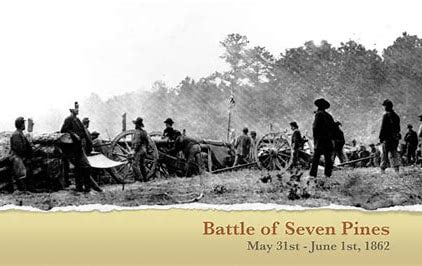June 1, 1862 – June 14, 1862
By Phil Kohn
Phil Kohn can be reached at USCW160@yahoo.com.
June 1, 1862: The Battle of Seven Pines, outside of Richmond, Virginia, continues for a second day. With Confederate Gen. Joseph Johnston having been seriously wounded on May 31, Gen. Robert E. Lee replaces him. President Lincoln sends a telegram to Gen. McClellan, telling him: “Hold all your ground, or yield any only inch by inch and in good order.” The action ends inconclusively, with the South suffering 6,134 casualties and the North 5,031.
On June 3, the Confederates, in the face of a heavily armed Union flotilla heading down the Mississippi, evacuate Ft. Pillow, in Tennessee, leaving Memphis undefended, with a large Union force holding Corinth, Mississippi, just to the south.
Union Maj. Gen. Ormsby Mitchel’s 11,000 troops defeat a small Confederate force at Sweeten’s Cove, Tennessee, about 30 miles west of Chattanooga, on June 4.
After a two-hour clash at Memphis, in which federal gunboats maul a lightly armed Confederate defense fleet, the city surrenders to Union forces on June 6. From Baxter Springs, Kansas, a Union force marches southward into Indian Territory, where it engages with Col. Stand Watie’s Cherokee Mounted Rifles at Cowskin Prairie, in the Cherokee Nation. Despite a victory there, the Federal troops are recalled to Fort Baxter by their newly arrived commander, Col. William Weer.
Federal artillery bombards Chattanooga from the north side of the Tennessee River on June 7. In New Orleans, Maj. Gen. Benjamin Butler’s strained relationship with the city’s inhabitants sours even further when he orders the hanging of William Mumford. Mumford — prior to the city’s official occupation by Union troops — had removed and destroyed a U.S. flag that had been raised without authorization over the New Orleans Mint by a squad of U.S. Marines. (The city’s surrender was still being negotiated.) Nevertheless, Mumford was seized by order of Butler, tried before a military tribunal and found guilty of treason. Butler had him publicly hung at the Mint.
Col. James Carleton, whose California Column of Union infantry, cavalry and artillery, had arrived at Tucson the previous day, on June 8 declares the Federal Territory of Arizona. Carleton pronounces himself military governor, establishes martial law in the almost-deserted town, and requires residents to take an oath of allegiance to the United States or leave. (In March 1862, the U.S. House of Representatives had passed a bill establishing the Arizona Territory, which would be the western half of the existing New Mexico Territory [rather than using the Confederate delineation of the southern half of New Mexico]. In February 1863 the U.S. Senate concurs and President Lincoln on 24 February 1863 signs the Act that creates the U.S. Territory of Arizona, located between New Mexico and California.)
Stonewall Jackson’s Shenandoah Valley campaign comes to an end on June 9 after Confederate victories at Cross Keys and Port Republic, Virginia. In 48 days of marching, Jackson’s “foot cavalry” has covered 676 miles, fought in five battles and kept some 60,000 Federal soldiers tied up and unable to reinforce McClellan. Jackson leads his troops southward out of the Valley to aid in the defense of Richmond.
On June 12, Confederate Maj. Gen. Jeb Stuart takes a force of 1,200 cavalrymen on a four-day reconnaissance that completely circles McClellan’s Union forces. The “Ride” seriously undermines the morale of the Federals and adds to McClellan’s belief that he is facing a larger Confederate force than is the case. (In fact, Gen. Lee’s newly named Army of Northern Virginia numbers only 74,000 soldiers versus the 105,000 of the Army of the Potomac led by McClellan.)
At Tupelo, Mississippi, on June 14, Gen. Pierre Beauregard, having never fully recovered from an 1861 throat operation, places himself on sick leave and departs for Mobile, Alabama, for rest. In Texas, Brig. Gen. Henry Sibley leaves Fort Bliss and leads the tattered remnants of his Army of New Mexico on the 630-mile trek back to San Antonio. Back in Confederate Arizona, troopers of Col. William Steele’s 7th Texas Cavalry — left behind as a rear guard by Sibley — are attacked while on a foraging expedition and skirmish with local residents near Socorro.




